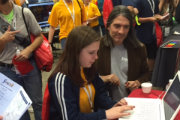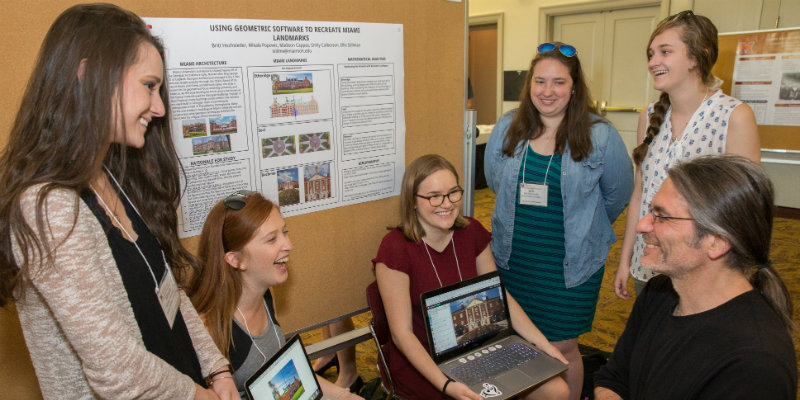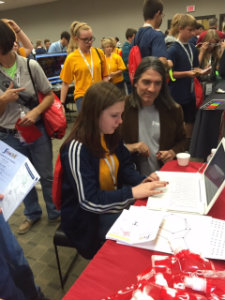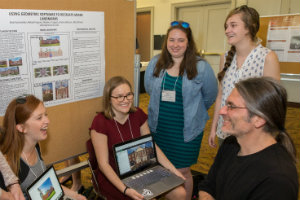Exploring the Language of Life Through the Wonder of Math


James M. Loy, Miami University
Listen to the audio podcast
Read the story
Dr. Todd Edwards wants to tell you a story. It’s about math. But it’s not just about numbers. This story is also about history and philosophy, conflict and culture, and even love and loss.
This, perhaps, presents a way of seeing the subject that may depart from our typical experiences. For Edwards, a Miami University professor of mathematics education, that’s all part of the plan.
“Generally, that’s my mission in life,” he says, “to encourage future teachers to connect their instruction to things that matter. When I was in school, math was often taught devoid of any context.”
Without context, math can often seem dry and sterile, especially to those who never found much joy in it. Thoughts of factoring polynomials, solving expressions, teachers at a board filled with esoteric formulas and symbols can still reinforce preconceptions of a subject that is too difficult, or daunting.
Or maybe just uninspiring.
“In literature we talk about the human condition and life and death and passion,” Edwards says. “And how can 6x2 + 9 = 0 compete with that?”
“Putting the people back into math”
But Edwards sees no reason why math shouldn’t resonate in the same way. And his goal is to make math meaningful to students by connecting it to their lives in ways that do matter.
“Miami is putting the people back into math,” says Abigail Fergus, a middle childhood education major. “We are looking at what students need more than what the math needs. We are not necessarily focusing on the formulas that everyone hates learning through flash cards or repetitive practice. We are seeing how we can make sense of what we already know, and then work our way into formulas.”
 Edwards often illustrates this process throughout his courses by designing creative lessons and class projects that emphasize exploration and discovery. Here, EHS preservice teacher education students focus on “rich math tasks,” which are less about memorizing calculations and more about the creative processes that draw connections across the living world.
Edwards often illustrates this process throughout his courses by designing creative lessons and class projects that emphasize exploration and discovery. Here, EHS preservice teacher education students focus on “rich math tasks,” which are less about memorizing calculations and more about the creative processes that draw connections across the living world.
After a viral story reported that the filling in Double Stuf Oreos wasn’t actually 2x as much, for example, Edwards encouraged critical inquiry and boosted quantitative literacy by helping students actually test the claim through rigorous data collection and statistical analysis.
In another course, teacher education students use sections of a high school math textbook to lead lessons for their peers. But they are given the freedom to interpret and design these lessons as they wish.
His work also frequently incorporates and emphasizes writing as well, which serves as both a teaching philosophy and pedagogical tool. “To me, teaching and writing are inextricably linked,” he says.
And this is an approach that also underscores a major new literary project.
Meaningful connections, local collaborations
This semester, Miami students taking his course in mathematics history and technology are authoring original children’s picture books featuring the biographies of important mathematicians.
The project first involves an initial review of common core standards, followed by research around the life and work of their chosen mathematician. Then, the class will partner with a group of local sixth grade middle schoolers, who will help the college students learn how to relate various concepts to young learners and possibly even serve as illustrators.
Afterwards, the middle schoolers and their teachers will vote on the top three picture books, which will be published in the Ohio Journal of School Mathematics.
For her book, Hannah Van Dyke, an EHS middle childhood education major, is writing about Thales of Miletus, who was the first person to use geometry to calculate real world distances and heights.
“Thales of Miletus had a lot in common with the 7th and 8th grade standards, which is why I chose him,” Van Dyke says. “And he also had conflict in his life and I think it’s relatable for a lot of middle schoolers.”
Abigail Fergus choose Evelyn Boyd Granville, one of the first African American women to earn a doctorate in mathematics and who eventually worked for NASA.
“Despite racial and sexist discrimination, Granville never gave up, was discouraged, nor questioned herself which is something that I think all students should see as a role model characteristic,” Fergus says.
And because of his love of writing and profound respect for the process, Edwards, too, is creating his own picture book right alongside his students.
Working in collaboration with Lori Gloeckner, a Talawanda middle school math teacher, Edwards is writing about an Iranian woman who overcame extreme racial and cultural biases to become the first and (so far) the only woman to win the Fields Medal, the most prestigious honor in mathematics.
Her name was Maryam Mirzakhani and she was born in 1977 just prior to the Iranian Revolution. At a young age, Mirzakhani was discouraged from studying math. But she met a teacher in high school who helped spark her passion anyway.
In 1995, she earned a perfect score at the International Mathematical Olympiad. In 2004, she earned a PhD from Harvard University, where she was distinguished by her “determination and relentless questioning."
And then, in 2017, three years after she accepted the Fields Medal for work on the symmetry of curved surfaces, she died of breast cancer at the age of only 40.
“I’ve fallen in love with her character,” Edwards says. “She’s such an inspiration in terms of her courage. So powerful. Truly pushing the boundaries for what it is possible for women to do in the world and it transcends mathematics.”
Both Edwards and his students envision these picture books as useful educational and communication tools that will help introduce young learners to new ideas and possibilities. Plus, they are also helping Miami students break down and reexamine math from a variety of historical, cultural, and social angles.
And for the rest of us, projects like these can also stand as a reminder that math does not always have to seem so sterile or devoid of context. That, as a subject, it might not be so disconnected from the inspirational and meaningful sides of life after all.
“I think it is possible to marry the best part of English and philosophy with math,” Edwards says. “That’s really the whole middle childhood philosophy, integrating content together and making connections. And I think what’s good for a kid in 6th grade is good for an adult as well. We all seek connections as human beings and the teaching of math deserves that respect too.”

